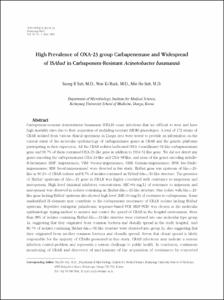High Prevalence of OXA-23 group Carbapenemase and Widespread of ISAba1 in Carbapenem-Resistant Acinetobacter baumannii
- Keimyung Author(s)
- Suh, Seong Il; Baek, Won Ki; Suh, Min Ho
- Journal Title
- Keimyung Medical Journal
- Issued Date
- 2012
- Volume
- 31
- Issue
- 1
- Keyword
- Acinetobacter baumannii; Bla OXA-23; Bla OXA-51; Carbapenem resistance; ISAba1; OXA-carbapenemase genes; REP-PCR.
- Abstract
- Carbapenem-resistant Acinetobacter baumannii (CRAB) cause infections that are difficult to treat and have high mortality rates due to their acquisition of multidrug-resistant (MDR) phenotypes. A total of 172 strains of CRAB isolated from various clinical specimens in Daegu area were tested to provide an information on the current status of the molecular epidemiology of carbapenemase genes in CRAB and the genetic platforms participating in their expression. All the CRAB isolates harboured OXA (oxacillinase)-51-like carbapnenemase gene and 90.7% of them
contained OXA-23-like gene in addition to OXA-51-like gene. We did not detect any genes encoding the carbapenemases OXA-24-like and OXA-58-like, and none of the genes encoding metallo-ß-lactamases (IMP: imipenemase, VIM: Verona-imipenemase, GIM: Germanimipenemase, SPM: Sao-Paulo-imipenemase, SIM: Seoul-imipenemase) were detected in this
study. ISAba1 gene was upstream of bla OXA-23-like in 90.1% of CRAB isolates and 8.7% of isolates contained an ISAba1 -bla OXA-51-like structure. The presence of ISAba1 upstream of bla OXA-23 gene in CRAB was highly correlated with resistance to imipenem and meropenem. High level (minimal inhibitory concentration; MIC=64 mg/L) of resistance to imipenem and meropenem was observed in isolates containing an ISAba1 -bla OXA-23-like structure. One isolate with bla OXA- 23-like gene lacking ISAba1 upstream also showed high level (MIC=64 mg/L) of resistance to carbapenems. Some unidentified IS elements may contribute to the carbapeneme resistances of CRAB isolates lacking ISAba1 upstream. Repetitive extragenic palindromic sequence-based PCR (REP-PCR) was chosen as the molecular epidemiologic typing method to monitor and control the spread of CRAB in the hospital environment. More than 98% of isolates containing ISAba1 - bla OXA-23-like structure were clustered into one molecular type group 1a, suggesting that they originated from common bacteria and clonally spread in the study hospital. And 86.7% of isolates containing ISAba1 -bla OXA-51-like structure were clustered into group 2a, also suggesting that they originated from another common bacteria and clonally spread. Given that clonal spread is likely responsible for the majority of CRABs presented in this study, CRAB infections may indicate a serious infection control problem and represents a serious challenge to public health. In conclusion, continuous monitoring of CRAB and discovery of mechanisms of the acquisition of
resistances by concerted multidisciplinary efforts and rigorous infection control measures are essential to help develop effective therapy regimens and to prevent the further spread of CRAB infections.
- Publisher
- Keimyung University School of Medicine
- Citation
- Seong Il Suh et al. (2012). High Prevalence of OXA-23 group Carbapenemase and Widespread of ISAba1 in Carbapenem-Resistant Acinetobacter baumannii. Keimyung Medical Journal, 31(1), 45–55.
- Type
- Article
- 파일 목록
Items in Repository are protected by copyright, with all rights reserved, unless otherwise indicated.
